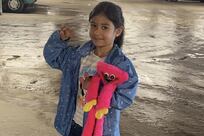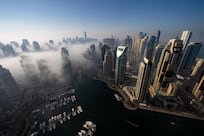Nine months ago, with the realisation that the nation would soon be entering its 40th year, The National created a team whose task it would be to commemorate the momentous events surrounding the day the country was born. We named it the History Project.
The name surprised some of the younger members of the team, born and raised in a country younger even than their parents. Surely this was not history? History was something that happened long ago. This was something still real, a school play where the luckiest pupil would get to wear a beard and a bisht and play Baba Zayed; a story to be learnt with the first letters.
How could this be history, especially as Sheikh Zayed would himself attend many of these celebrations? These were stories told by parents, a time recorded in family photo albums and anecdotes. Many of the people who worked so hard to create the UAE were still living; they were neighbours, friends and relatives. How could you teach Ittihad (the Union) as history, they asked, when we are still living it?
Sheikh Zayed, though, is no longer with us, and with his passing comes the realisation that time is short and memories are fading. This publication is a modest attempt to remind readers of the heroic effort required to build a nation and how one man never lost sight of the vision of a people united under one flag, which he accomplished against all odds.
Many of the photographs on these pages have never been seen before; many of those interviewed have never spoken at length about their recollections of the day. They include such men as Sheikh Faisal bin Sultan Al Qassimi, the first Under Secretary of the Ministry of Defence; Al Haj al Mehairbi, Sheikh Zayed's personal secretary; and Ramesh Shukla, a royal photographer, whose iconic images form a permanent record of December 2, 1971.
In addition to researching the archives of our sister paper, Al Ittihad, members of the team have visited Doha, Cairo, New York and London as well as institutions such as the National Center for Documentation and Research here in Abu Dhabi and the Centre for Middle East Studies at St Antony's College in Oxford.
At times we have felt more like detectives than journalists, piecing together and translating scattered accounts to build a more complete picture, poring over grainy black-and-white photographs for clues. Is that the wallpaper on the walls of Al Manhal Palace in Abu Dhabi or Union House in Dubai, where the nation was formed?
Sometimes the results have been surprising. A portfolio of images taken by Bruno Barbey, the renowned Magnum photographer, turned out to be an astonishing record of the celebrations for the fifth anniversary of the accession of Sheikh Zayed, just days before the creation of the nation he would soon lead.
They include never-before-seen images of the great diva of Arab song, Umm Kulthum, who performed two concerts in Abu Dhabi to honour the new country. Film footage of that event has also been unearthed and can be viewed on our website.
Taken together, the pages that follow represent what we believe is a detailed account of the events surrounding the day. Yet gaps remain and we must apologise now for any errors or omissions. One of the tasks ahead in the next 12 months is to build a more complete picture of the country's first four decades, to leave a lasting resource that will contribute to our sense of national identity.
We hope that you, the reader, will help. As for ourselves, we are a group of young and old, Emiratis, Arabs and expatriates. This does not seem the place to single out individuals for credit. Like the Rulers of 40 years ago, we have learnt that the best is achieved in unity.





